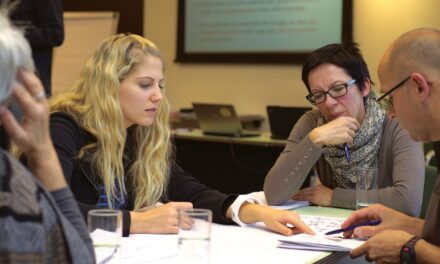Image by Michal Jarmoluk
What does it take in human resources for a company to be tops in innovation and high performance? The answer might surprise you.
Naturally, to start, the HR department must assemble an organization that continually supports the company’s innovation business model.
Every company wants to innovate to stay competitive. So, it’s not merely a question of wanting to be successful. A lot depends on the planning and having the right people to carry out the planning.
That’s the hard part. There’s a dire shortage of determined, talented innovators who are available to be recruited for high performance.
Just look at the 7.3 million unfilled jobs. Many Americans don’t have the technical or soft skills required for companies to compete in the gig economy.
Assembling the right team
The right team has diversity in talent and experience to create opportunities for business growth.
The right people have big picture views which are drawn from their rich backgrounds so they’re capable of driving disruption. Further, they must fit together smoothly as a team.
The talent mix is paramount for the entire life cycle in creating and innovating.
The people with the right skill sets must be able to work well with each other. It truly takes a village and cross-functional experience. And they must be flexible to deal with change.
Leading the culture
For innovation, an organization must also have a leader who has vision. That’s someone who takes charge of innovation initiatives but keeps an eye on the talent.
Often, not every member of the team has the skill sets to envision ideas, collaborate and execute. That means the leader must be capable of adjusting the team’s structure.
At this point, non-team members including HR need to stay out of the process.
In order for a team to be successful, the individual members must originate and own the ideas – vis-à-vis being assigned the ideas – and be given freedom to do their work.
After all, they’re the ones with the big ideas and don’t need handcuffs to govern them.
Functional expertise
While it’s best if they’re passionate, the leader must recognize certain team members might not be the right people to see the projects to completion.
Why? Functional expertise is critical to consider. That’s why a rich background comes from cross-functional experience.
Someone might be the right person to create the vision, but might not be the right person to keep adapting to change and to execute the planning.
Size of the team matters: There needs to be enough talent but the people need to be apportioned appropriately for agility.
Agility is frequently difficult for large companies so the right operating model is important.
HR department
HR is important at the outset in helping to select talent.
HR must be capable of picking the right people for the right roles. A person might be great to create an initiative but have difficulty in seeing innovation to fruition.
HR and management have to use discretion.
Not all people deliver the same level of competency in their work. Fairness in recognition is important and so is not having a too-heavy of a hand in evaluating and rewarding employees.
Emphasis should be given to the people who contribute the most in creation and value.
Curiosity to fill needs
A company must have people who know how to find a need to fill in the marketplace. There must be people who understand the vision enough to market the initiative throughout the firm.
Others must be able to prioritize in identification and make fast decisions in testing, generation and execution to turn an initiative into reality.
But again the totality of the team is important in terms of complementary skill sets to work together well.
Along the way, the ideal persons subconsciously emulate Michelangelo whose motto was “I am still learning.”
Learning, taking risks, dealing with change and admitting mistakes are all part of this principle.
Otherwise, it’s difficult to scale an idea for innovation.
Motivation
There are surprises along the way. Unforeseen obstacles appear. This calls for the team’s ability to pivot.
What must happen is that one or more persons must admit personal strengths and weaknesses and strive for improvement.
Only then are they able to spot issues that stymie the work and push for a change in direction or a redeployment of resources.
The leader must be able to view the situation and see what it means for the operating model.
Therefore, the team needs a balance between focusing on the individual’s pathway vis-à-vis the overall welfare of the team and its collective success in pursuing innovation.
Conclusion
Success in staffing your team for innovation and high performance all boils down to being able organize, mobilize and cultivating the right culture.
The right talent is only as effective as the success in configuring the team and seeing projects to successful fruition.
And when companies are successful, it will be easier for them to attract even more of the best talent.
From the Coach’s Corner, related information:
As Tech Disrupts, HR Strategies to Meet Future Staff Needs — Tech innovations such as artificial intelligence, 3D printing and driverless cars threaten businesses that already have challenges in human resources. It’s critical to identify the future skills and roles companies will need in their staffing, and to make needed changes. Here’s how.
Solutions If You Want to Rise to the Top in Innovation — To become an innovative leader and to participate in turbo-charging the economy, it’s vital to continually evaluate your organization and strategize for success. Here’s how.
Innovation & Culture – Ford Once Drove with a Better Idea — Ford Motor Company’s stalling in the pursuit of profits stems from many reasons. For a business game-changer, the company would profit from the lessons of its former leaders and these seven basic principles for innovation in planning and culture change.
Profitability: 8 Ways to Create a Disruptive Business Model — Businesses seeking the spotlight and staying ahead of the competition should look for opportunities to embrace change and act quickly to be a first-mover in disruption. Here’s how.
To Profit from AI, Companies Need to Effect a Cultural Shift — To develop a fertile environment for innovation using artificial intelligence, a cultural shift is often needed. Here are strategies to be successful.
“Learning and innovation go hand in hand. The arrogance of success is to think that what you did yesterday will be sufficient for tomorrow.”
-William Pollard
__________






